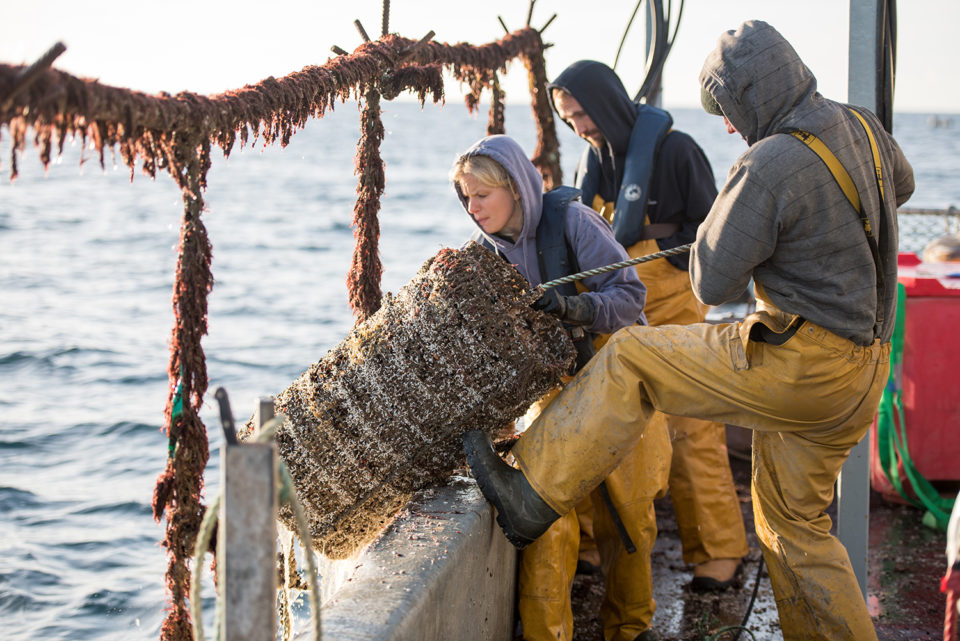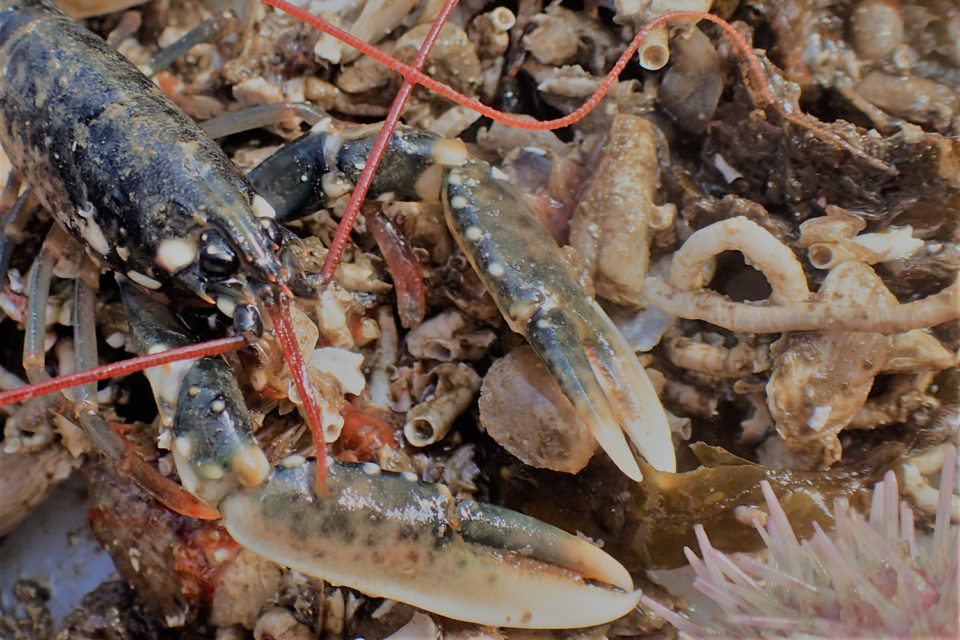National Lobster Hatchery aims to provide answers for the science of stock enhancement

A new project to grow lobsters in the open sea is giving researchers hope that the technology behind stock enhancement could be significantly improved and that lobster farming could perhaps become the future for people living in coastal areas, providing new prospects for diversification and employment.
The United Kingdom’s National Lobster Hatchery (NLH) is a pioneering conservation, research and education charity that aims to preserve coastal marine biodiversity and help protect vulnerable lobster populations. Traditionally, it has achieved this goal through stock enhancement.
NLH was set up in 2000 in response to declining local lobster populations and the collapse of stocks in Scandinavian and Mediterranean countries. It operates from a small building on the quayside in Padstow, Cornwall, which also houses a busy visitor education center that hosts 45,000-plus people annually.
Results from the hatchery are equally impressive, with more than 20,000 juvenile lobster produced and released each year since it was set up.
In practical terms, lobster is not a major earner for the UK inshore fishing fleet, compared with its counterparts in Canada and North America, but it still contributes more than £32 million to the economy annually and is an important source of income for many small-scale fishermen.
“The existing capture fishery supplies just 5,000 metric tons of European lobster per year, but we know that there is a ready market for around 120,000 metric tons of lobster, which leaves plenty of scope for expansion,” said Dr. Carly Daniels, research and development manager at NLH. “This knowledge provides the impetus for our development work, which has produced some unexpected and exciting results over the past couple of years.”
Cultivating lobster larvae a complex process
The process of producing baby lobsters is complex but NLH now has it down to a fine art. Around 200 berried (egg bearing) lobsters are brought into the hatchery each year by local fishermen, and kept in seawater tanks until their eggs hatch. Each female lobster can carry approximately 40,000 eggs, depending on her size.
Hatching takes place at night, with the larvae swimming upwards, away from the mother. These are channelled into a conical vessel and collected by staff each morning. Spent lobsters are returned to the donor fishermen or wholesaler.
If the eggs are not fully ripe, lobsters can be kept in chilled conditions to slow development, which spaces out the hatching process and eases pressure on the culture tanks. This is particularly useful when the facility is busy.
Lobster larvae are transferred to conical upwelling rearing tanks where they are fed plankton, and kept for around two weeks until they reach their third moult. Lobster larvae go through four moult stages, during which they develop vital body parts and learn to look after themselves. They loosely resemble prawns at first, but after the third moult, they start to take on a lobster shape and become good swimmers.
At this point in the wild, they take up an existence on the seafloor and are thought to dig tunnels where they live for a couple of years.
In the hatchery, the third stage marks a time where they need be separated into individual rearing compartments, as their aggressive territorial behaviour makes them liable to attack each other. European lobsters have two distinctive claws; a large bulky one for crushing, and a thinner one for cutting. Combined, they make for a dangerous foe.
NLH uses a stacking Aquahive system developed by Shellfish Hatchery Systems Ltd in Scotland, which consists of cylindrical containers with circular trays divided into individual sections. Each unit can house up to 4,000 juveniles, giving the hatchery a current capacity of 24,000 juvenile lobsters.
Owning your own lobster farm might be a future possibility for people with a boat, the practical skills, the right mind-set and an entrepreneurial attitude.
Once in containers, lobsters are weaned onto a formulated feed and the NLH is working with several companies to assess and improve the quality and performance of diets.
“The introduction of Aquahives and improvements in feeds have made a huge difference to hatchery production,” said Daniels.
Lobsters ready for release have traditionally been taken by local fishermen and divers to offshore and nearshore locations around Cornwall and the Isles of Scilly, and despite some extensive historical research undertaken mostly in the 1990s, the science of stock enhancement is in desperate need of updating.
“We have undertaken limited work on tagging and genetic typing and hope to embark on the first quantitative assessment of the success of lobster releases using physical, genetic and/or acoustic tagging. This work will hopefully provide some much-needed answers for the science of stock enhancement,” said Daniels.

Developing lobster aquaculture
Recently, Daniels and her team have embarked on two projects (Lobster Grower 1 and 2, funded by Innovate UK and the Biotechnology and Biological Sciences Research Council (BBSRC) to develop a sea-based culture system in conjunction with the University of Exeter, the Centre for Environment, Fisheries and Aquaculture Science, Falmouth University and Fusion Marine. Lobsters are grown in compartmentalized lanterns, need no feed input, and thrive in the natural environment provided by these artificial reef systems.
“Initially, we wanted to see how juvenile lobsters would grow in environmentally enriched containers out in the open ocean. Our vision was to provide an ecological conditioning step, to grow juvenile lobsters to a larger size before releasing them to the seabed,” said Daniels. “In this way, we hoped that a higher percentage would then survive to adulthood, and improve the charity’s stock enhancement efforts.”
Early results were promising, particularly the trial site that integrated lobster containers with a rope-grown mussel farm, Westcountry Mussels of Fowey, in St. Austell Bay.
“We found that there was potential for rearing lobsters to even larger sizes, so we started to look at the containers’ potential as both a nursery and ongrowing aquaculture system. We were particularly excited to find that the juvenile lobsters grew faster and appeared much fitter than the control animals grown in the hatchery,’’ she said.
Daniels is now exploring the potential for market diversification, and the possibility of producing a small lobster, similar in size to a langoustine.
However, before this can happen, there are many regulatory hurdles to consider and NLH is working with the Centre for Environment, Fisheries and Aquaculture Science (CEFAS) to see if such market diversification would be possible, and what the wider implications for the existing market would be.
Funded until 2019, Lobster Grower 2 is facilitating ongoing improvements to the containerized system and assessments into the practicality of undertaking lobster mariculture on a larger scale. Investigations into lobster growth, survival, health and quality are all under way.
Daniels is thrilled by the many possibilities opening up for lobster enhancement and aquaculture programs.
“It is quite feasible that this project could be cascaded down to small fishing communities,” she said. “The initial start-up costs would be fairly low, and maintenance is minimal, so owning your own lobster farm might be a future possibility for people with a boat, the practical skills, the right mind-set and an entrepreneurial attitude.”
Author
-
Nicki Holmyard
Nicki Holmyard has written about the seafood industry for longer than she cares to remember! A committed pescetarian, she is also a partner in the UK’s first fully offshore rope-grown mussel farm.
Tagged With
Related Posts

Innovation & Investment
Aquaculture Exchange: Bill Herzig
The Global Aquaculture Alliance will honor seafood procurement expert Bill Herzig with a Lifetime Achievement Award during its annual GOAL conference. He talked to the Advocate about top-to-bottom commitment to sustainability and the ambitious lobster aquaculture project he spearheaded in Malaysia with Darden Restaurants.

Responsibility
The odd wedge sea hare is useful as an ‘algae cleaner’
Marine gastropod molluscs known as sea hares are relatively unknown animals that have significant importance in biomedical research due to their particular nervous system. And because of their ability to consume large amounts of algae, they can be very useful in clearwater, marine aquaculture systems.

Aquafeeds
A look at protease enzymes in crustacean nutrition
Food digestion involves digestive enzymes to break down polymeric macromolecules and facilitate nutrient absorption. Enzyme supplementation in aquafeeds is a major alternative to improve feed quality and nutrient digestibility, gut health, compensate digestive enzymes when needed, and may also improve immune responses.

Intelligence
An inside look at Sino Agro Foods’ giant prawn MegaFarm
Sino Agro Foods has developed a proprietary recirculating aquaculture system that yields high production volumes and profitability. The facility should significantly contribute to seafood production in China and to help satisfy increasing demand for high value, safe and sustainably produced seafood.


